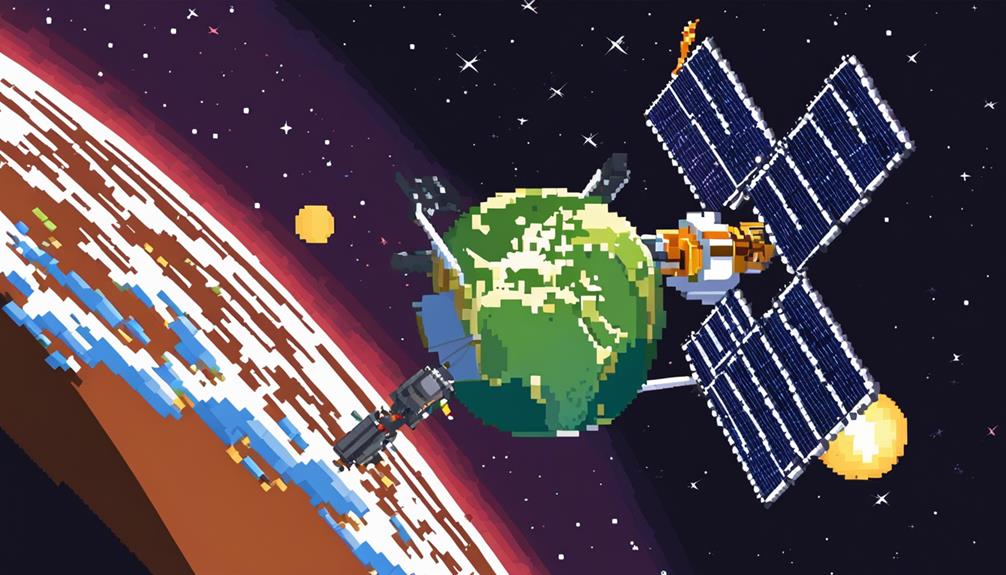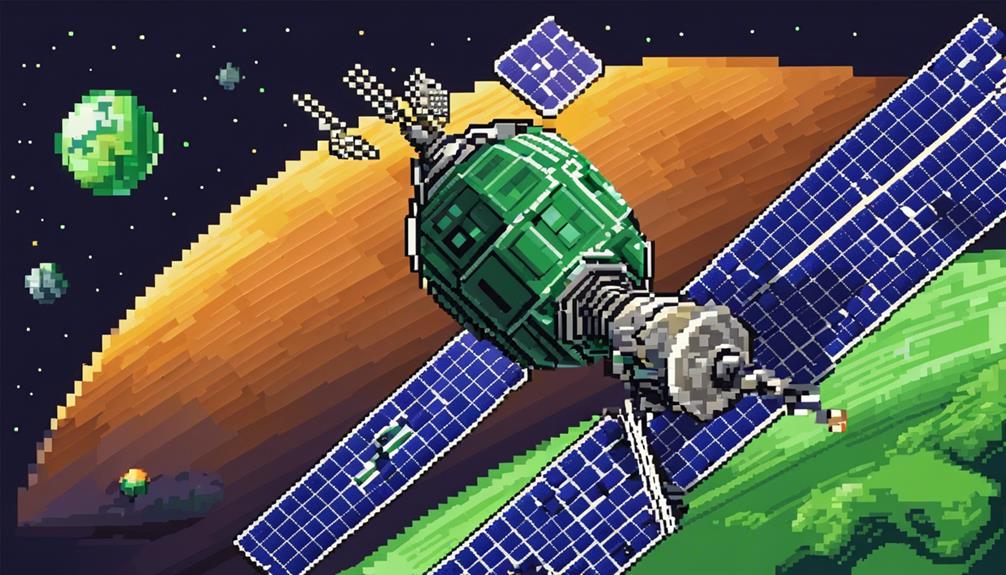In the ever-evolving realm of satellite propulsion, the shift towards green alternatives has sparked significant interest within the space industry. The quest for environmentally friendly solutions has led to innovative approaches like wax-based propellants and ADN-fueled engines, offering a glimpse into a more sustainable future for space travel. As research continues to explore the potential of these green propulsion technologies, the discussion around their efficiency, scalability, and long-term viability becomes increasingly critical. The journey towards greener satellite fuel options promises not only environmental benefits but also a transformative impact on the future of space exploration.
Key Takeaways
- ADN-based fuels offer improved performance and safety benefits.
- Green propellants reduce environmental and health risks.
- Cost reductions and operational efficiency are achievable with green propulsion.
- Industry is investing in cleaner fuel technologies for sustainable space travel.
Environmental Impact of Traditional Satellite Fuels

Traditional satellite fuels, such as hydrazine, have a significant environmental impact due to their highly toxic and corrosive nature, posing risks to both ecosystems and human health. Hydrazine emissions contribute to air pollution and can harm living organisms if released into the atmosphere. The handling and transportation of traditional satellite fuels require strict safety measures and specialized equipment to prevent accidents, further emphasizing the hazards associated with these fuels. The environmental impact of traditional satellite fuels extends beyond air pollution; it also includes carbon emissions and the contamination of soil and water sources.
As a result of these environmental concerns, there has been a growing interest in developing green propellants as environmentally friendly alternatives to traditional satellite fuels. Green propellants are designed to minimize the negative impact on the environment while still providing the necessary thrust for satellite propulsion. By transitioning to green propulsion alternatives, the space industry can significantly reduce its carbon footprint and mitigate the risks posed by toxic and corrosive fuels like hydrazine. Embracing environmentally friendly propellants is crucial for sustainable space exploration and ensuring the long-term health of our planet.
Advantages of Green Propulsion Alternatives
Given the environmental concerns associated with traditional satellite fuels, the advantages of green propulsion alternatives, such as ADN-based fuel, become increasingly apparent in terms of performance, safety, and operational efficiency. Green propulsion alternatives offer a range of benefits that make them a compelling choice for satellite missions:
- Enhanced Performance: ADN-based fuels provide a 30% improvement in performance compared to traditional hydrazine propellants. This increased efficiency allows for better maneuverability and longer mission durations.
- Safety and Environmental Benefits: Green propellants are safer, less toxic, and easier to handle than conventional rocket fuels, reducing risks to both the environment and human health. The use of ADN-based fuel significantly minimizes potential hazards during transportation, storage, and operation.
- Operational Efficiency: ADN-based fuels can be transported by aircraft safely and handled without the need for extensive protective gear. This enhances operational safety and streamlines mission logistics, leading to more efficient space operations.
- Cost-Effectiveness: The adoption of green propulsion alternatives not only benefits the environment but also leads to cost reductions in satellite missions. By improving safety, efficiency, and performance, these alternatives contribute to overall mission success while reducing operational expenses.
Challenges in Implementing Green Propulsion

Addressing the hurdles associated with the adoption of green propulsion technologies requires a strategic approach to overcome key challenges. Cost reduction remains a significant obstacle as the initial investment and operational costs of green alternatives can be higher than traditional propulsion systems. Moreover, coordination among stakeholders is essential to secure funding for research and development initiatives aimed at advancing green propulsion technologies. Technological barriers such as safety, reliability, and concerns about the overall cost-effectiveness of these systems need to be effectively addressed to gain wider acceptance in the space industry. The development of renewable fuels is still in its early stages, posing challenges for their widespread adoption in propulsion systems.
To provide a clearer overview of the challenges in implementing green propulsion, the following table outlines the key obstacles faced in transitioning towards more sustainable space travel solutions:
| Challenges | Description |
|---|---|
| Cost Reduction | Higher initial and operational costs compared to traditional systems. |
| Stakeholder Coordination | Essential for securing funding for research and development initiatives. |
| Technological Barriers | Safety, reliability, and cost-effectiveness concerns need to be addressed. |
| Renewable Fuel Development | Still in early stages, posing challenges for widespread adoption. |
| Sustainability Innovation | Focus on carbon-neutral launches and cleaner propulsion technologies for a more sustainable space industry. |
Emerging Technologies in Space Propulsion
An array of emerging technologies in space propulsion is revolutionizing the industry with innovative and cost-effective solutions. These advancements are crucial in addressing the challenges associated with traditional rocket propulsion systems, including their toxicity and environmental impact. Key developments in this field include:
- Wax-Based Propellants: Wax-based propellants have emerged as a cost-effective and less toxic alternative for rocket propulsion. The efficient production of wax fuel grains in microgravity environments, with reduced rotation rates, showcases their potential for use in space missions.
- Beeswax and Candle Wax Research: Research conducted at Stanford University has shown promising results regarding the use of beeswax and candle wax as rocket propellants. These natural materials offer environmentally friendly options for propulsion systems.
- Exploration of Green Propellants: Green propellants such as ADN, H2O2, and ionic liquids are being actively explored as substitutes for traditional toxic propellants. These environmentally friendly alternatives demonstrate the industry's commitment to developing sustainable rocket propulsion technologies.
- ALM Manufactured H2O2 Thrusters****: The development of additively manufactured (ALM) H2O2 thrusters highlights significant advancements in cost-effective and flexible propulsion technology. This innovation showcases the potential for utilizing cutting-edge manufacturing techniques in space propulsion systems to enhance efficiency and performance.
Future Prospects for Green Satellite Fuels

Future advancements in green satellite fuels are poised to revolutionize the propulsion systems used in space missions. The development of environmentally friendly propellants such as Dinitramide (ADN) holds great promise for the future of satellite fueling. ADN-based fuels offer significant advantages over traditional options like hydrazine. They are less toxic, easier to handle, and safer for the environment, making them a more sustainable choice for rocket engines. For example, the HPGP thruster design, which utilizes green propellants like LMP-103S, not only provides better performance but also enhances the safety of satellite missions. These advancements in green satellite fuels could lead to a reduction in risks and costs associated with space operations.
Moreover, the industry's increasing interest in adopting green satellite fuels underscores the potential for a shift towards more sustainable space travel practices. The new HPGP thruster, with its improved efficiency and environmental benefits, demonstrates the ongoing efforts to promote eco-friendly propulsion systems for satellites. As technology continues to advance, the integration of green propellants like ADN into satellite missions is expected to play a crucial role in shaping the future of space exploration. The utilization of these innovative fuels has the potential to not only enhance mission success but also contribute to a cleaner and safer space environment.
Industry Efforts Towards Sustainable Space Travel
Efforts by leading aerospace companies and research institutions are driving significant advancements in sustainable space travel through investments in cleaner fuel technologies. The following industry efforts showcase the progress being made towards more environmentally friendly rocket propulsion:
- SpaceX, Blue Origin, Rocket Lab, Relativity Space, and Virgin Galactic: These companies are actively investing in cleaner fuel technologies for space travel, aiming to reduce the carbon footprint of rocket launches.
- Green Hydrogen International: Working on a green hydrogen project to develop environmentally friendly rocket fuel, which has the potential to revolutionize the way rockets are propelled into space.
- German Aerospace Center: Developing a fuel that produces only nitrogen, oxygen, and water for sustainable space propulsion, offering a cleaner alternative to traditional rocket fuels.
- Hyox: Focused on creating net-zero aviation fuel and rocket propellants to reduce the environmental impact of space missions, aligning with the broader goal of achieving sustainable space travel.
Additionally, the Swedish Space Corporation has also been actively exploring sustainable alternatives for rocket propulsion, underscoring the global effort to make space travel more eco-friendly. These initiatives pave the way for a greener future in the aerospace industry, where sustainability is a top priority.
Frequently Asked Questions
What Are Alternatives for Rocket Fuel?
Alternative rocket fuels encompass biofuel options and electric propulsion innovations. Biofuels, derived from renewable sources like algae or waste, offer sustainable alternatives, while electric propulsion systems, like ion or Hall-effect thrusters, use electricity for propulsion. With a growing emphasis on environmental sustainability, these advancements in rocket fuel technology are reshaping the aerospace industry. The pursuit of cleaner, more efficient fuels is a pivotal step towards reducing carbon emissions in space exploration.
What Are the Most Efficient Propulsion Systems?
Electric propulsion systems, such as ion thrusters and Hall-effect thrusters, are recognized for their high efficiency and specific impulse, making them the most efficient propulsion systems available. These systems utilize electrical power to accelerate propellant ions for thrust, enabling higher speeds and efficiencies compared to traditional chemical propulsion. Solar electric propulsion, which uses solar panels to generate electricity for ion thrusters, offers continuous acceleration in space, ensuring fuel savings and extended mission durations.
What Are the Different Types of Satellite Propulsion?
When discussing the different types of satellite propulsion, two prominent systems stand out: electric propulsion and solar sails. Electric propulsion systems, like ion thrusters, offer high efficiency but lower thrust levels compared to traditional chemical systems. On the other hand, solar sails utilize solar energy to generate propulsion, providing a unique and environmentally friendly alternative for satellite maneuvering. These innovative technologies are shaping the future of satellite propulsion in space exploration.
What Is the Best Propulsion for Space?
When considering the best propulsion for space missions, factors such as efficiency, speed, and sustainability are crucial. Options like solar sails and ion thrusters offer long-term propulsion solutions ideal for deep space exploration. On the other hand, nuclear propulsion and plasma engines provide high thrust capabilities for faster interplanetary travel. Each propulsion system has its advantages and is best suited for specific mission requirements, highlighting the importance of selecting the most suitable option for each space endeavor.

